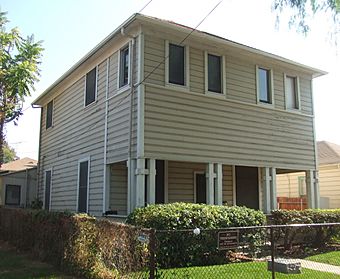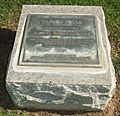Harada House facts for kids
|
Harada House
|
|

Harada House
|
|
| Location | 3356 Lemon Street, Riverside, California |
|---|---|
| Area | less than one acre |
| Built | 1884 |
| Architect | Harp Brothers |
| NRHP reference No. | 77000325 |
Quick facts for kids Significant dates |
|
| Added to NRHP | September 15, 1977 |
| Designated NHL | December 14, 1990 |
The Harada House is a historic home located in Riverside, California. This house became very important because of a big court case. The case was about a law from 1913 called the California Alien Land Law of 1913. This law tried to stop people who were not allowed to become U.S. citizens from owning land. The state of California tried to take the house from the Harada family. But the Haradas fought back and won their case. They kept their home. The house was built in 1884. The Harada family later made it bigger. In 1990, it was named a National Historic Landmark. Today, the Museum of Riverside helps take care of it.
Contents
About the Harada House
The Harada House is found close to downtown Riverside. It sits on the east side of Lemon Street. When it was first built in 1884, it was a one-story house. It had a simple design with wood siding and a wood shingle roof. In 1916, the Harada family added a second floor. This new part included four bedrooms, a bathroom, and an open front porch. Now, it looks like a regular two-story house with wood siding. It has a two-story porch at the front. The second floor of the porch is now closed in. Many parts of the house, like its wallpaper and other original features, have been kept safe. This is because the house's changes were part of the court case.
The Harada Family's Story
Coming to California
In the early 1900s, Jukichi Harada moved from Japan to California. His wife, Ken, and their first son, Masa Atsu, came with him. The Harada family settled in Riverside, California. They rented a boarding house and also ran a restaurant. While living there, they had three more children: Mine, Sumi, and Yoshizo. In 1913, the family's five-year-old son, Tadao, sadly passed away. This made Jukichi Harada want to find a new, bigger home for his family. He looked for a house that was near their church and where his children went to school.
The Court Case: California v. Harada
Jukichi Harada bought the house in 1915. He put the house's ownership in the names of his three youngest children. This was because his children were born in the United States. This made them U.S. citizens. Jukichi and Ken Harada were immigrants from Japan. At that time, a law from 1913 stopped people from Japan from owning land in California. After the Haradas bought the house, some neighbors tried to make them leave. But the Haradas stayed.
In October 1916, the state authorities started a lawsuit against the Harada children. They wanted the state to take ownership of the house. The court hearings for the case, called California v. Harada, began in December 1916. This case was very important. It tested if American-born children of Japanese immigrants had the right to own property. The case also got attention from other countries. This was because of the agreements between the U.S. and Japan at the time.
The hearings finished in September 1918. Judge Hugh Craig decided that the Harada children had the right to own the house. He said that as American citizens, they could own property no matter their background. The state did not try to challenge this decision. So, the Haradas were allowed to keep their home.
Keeping the House Safe
During World War II, many Japanese American families, including the Haradas, were sent to special camps. These were called internment camps. While they were in the camp, both Ken and Jukichi Harada passed away. A friend of the family, who was not Japanese, lived in the house during this time. This helped the Harada family keep their home.
After the war, Sumi Harada, one of the three children who owned the house, took over. She let other Japanese families who had lost their homes stay there. This is when the upstairs porch was closed in to create more living space.
In the 1970s, a student named Mark Rawitsch started researching the Harada House. He worked with Sumi Harada. She had saved many family records. Together, they showed how important the house was to the City of Riverside. In 1977, the house became an official landmark. In 1991, the National Park Service recognized the house as a National Historical Landmark. After Sumi Harada passed away in 2000, her brother Harold took ownership. In 2004, the house was given to the Riverside Metropolitan Museum. This museum is now called the Museum of Riverside.
Restoring the House
The Museum of Riverside is working to fix up the Harada House. They want to make sure it is safe and can be visited by people. In November 2016, a group called the American Alliance of Museums told the museum that they needed to make plans to save and open the house. Experts are checking the house to understand what needs to be done. Even though some repairs have been made, more work is needed to make the house strong and safe. The goal is to carefully restore the house to its original condition.
The museum is also turning the house into a place for learning about history and culture. They raised money to buy the house next door, called the Robinson House. This will be used as a visitor center for the Harada House.
See also
- Bainbridge Island Japanese American Exclusion Memorial
- Day of Remembrance (Japanese Americans)
- Densho: The Japanese American Legacy Project
- Empty Chair Memorial
- Fred Korematsu Day
- Go for Broke Monument
- Japanese American Memorial to Patriotism During World War II
- National Japanese American Veterans Memorial Court
- Sakura Square
- Alien land laws
- List of National Historic Landmarks in California
- National Register of Historic Places listings in Riverside County, California





